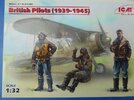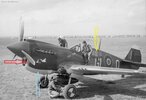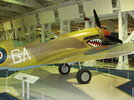stona
SMF Supporter
- Joined
- Jul 22, 2008
- Messages
- 11,478
- Points
- 113
- First Name
- Steve
This is a Kittyhawk III to those of us on the European side of the Atlantic. It had an Allison V-1710-18 engine, rated at 1200 h.p. for take off and 1125 h.p. at 17,300 feet, Merlin's being prioritised elsewhere.
The kit is from John (Scale Model Shop) and as is invariably the case was competitively priced and arrived almost as soon as I'd hit enter on my order. Fantastic service as usual.
The P-40M was built solely for Lend-Lease, the contract being approved on August 24, 1942. Most of them went to the RAF, the RAAF, and the RNZAF as the Kittyhawk III. The type served with British Commonwealth forces in the Far East. A number were operated in Italy by No. 5 Squadron of the South African Air Force, and it is one of these that will be my victim. The serial number FR817 implies that it was one of 264 P-40Ms supplied to the RAF as Kittyhawk IIIs (FR779/FR872 and FS100/FS269), this one ending up with the SAAF.
I have just finished a Kotare Spitfire, with a superb set of instruction, giving all sorts of well researched and accurate options and advice. The Trumpeter kit gives me this:
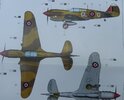
There is almost nothing correct here. The colours are wrong and the camouflage pattern is wrong.
Here's the actual aircraft.
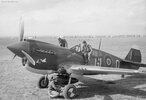
I don't think that this is in a tropical scheme but rather the US equivalent to the Temperate Land Scheme (Dark Green/Dark Earth over Sky). The camouflage pattern is also a US version of the British disruptive pattern, drawings for which survive, though apparently not available in China. It is close to that seen on other S/E British fighters and nothing like the one in the instructions.
I shall take a stab at the US colours. The upper surface colours, by the time this aircraft was produced, were fairly close to the original British colours, leaving the only really contentious issue as Curtiss's version of Sky, which was, apparently, not terribly close to our own.
The harness in the kit is wrong for this aircraft, the British fitted their own Sutton harnesses. The tyres are also wrong, not treaded like those above. I'll change the harness but will have to suck up the tyres.
Let's hope that the kit is better engineered than it is researched!
I'm waiting for some paints and a harness, but should be casting off and getting underway this week
The kit is from John (Scale Model Shop) and as is invariably the case was competitively priced and arrived almost as soon as I'd hit enter on my order. Fantastic service as usual.
The P-40M was built solely for Lend-Lease, the contract being approved on August 24, 1942. Most of them went to the RAF, the RAAF, and the RNZAF as the Kittyhawk III. The type served with British Commonwealth forces in the Far East. A number were operated in Italy by No. 5 Squadron of the South African Air Force, and it is one of these that will be my victim. The serial number FR817 implies that it was one of 264 P-40Ms supplied to the RAF as Kittyhawk IIIs (FR779/FR872 and FS100/FS269), this one ending up with the SAAF.
I have just finished a Kotare Spitfire, with a superb set of instruction, giving all sorts of well researched and accurate options and advice. The Trumpeter kit gives me this:

There is almost nothing correct here. The colours are wrong and the camouflage pattern is wrong.
Here's the actual aircraft.

I don't think that this is in a tropical scheme but rather the US equivalent to the Temperate Land Scheme (Dark Green/Dark Earth over Sky). The camouflage pattern is also a US version of the British disruptive pattern, drawings for which survive, though apparently not available in China. It is close to that seen on other S/E British fighters and nothing like the one in the instructions.
I shall take a stab at the US colours. The upper surface colours, by the time this aircraft was produced, were fairly close to the original British colours, leaving the only really contentious issue as Curtiss's version of Sky, which was, apparently, not terribly close to our own.
The harness in the kit is wrong for this aircraft, the British fitted their own Sutton harnesses. The tyres are also wrong, not treaded like those above. I'll change the harness but will have to suck up the tyres.
Let's hope that the kit is better engineered than it is researched!
I'm waiting for some paints and a harness, but should be casting off and getting underway this week

Last edited:

